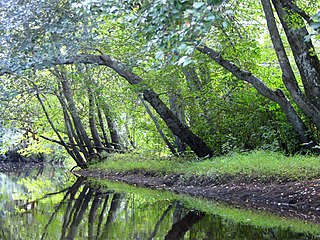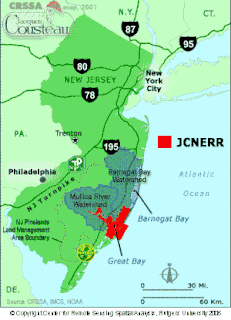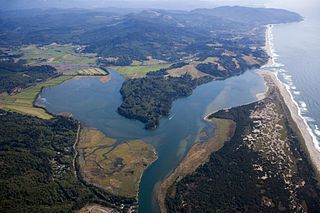This article needs additional citations for verification .(April 2011) (Learn how and when to remove this template message) |
Ballanger Creek is a 4.7-mile-long (7.6 km) [1] tributary of the Mullica River in southern New Jersey in the United States. The name is derived from "Belangee," a family of French Huguenots who were early settlers in the area.

A tributary or affluent is a stream or river that flows into a larger stream or main stem river or a lake. A tributary does not flow directly into a sea or ocean. Tributaries and the main stem river drain the surrounding drainage basin of its surface water and groundwater, leading the water out into an ocean.

The Mullica River is a 50.6-mile-long (81.4 km) river in southern New Jersey in the United States. The Mullica was once known as the Little Egg Harbor River.

New Jersey is a state in the Mid-Atlantic region of the Northeastern United States. It is a peninsula, bordered on the north and east by the state of New York, particularly along the extent of the length of New York City on its western edge; on the east, southeast, and south by the Atlantic Ocean; on the west by the Delaware River and Pennsylvania; and on the southwest by the Delaware Bay and Delaware. New Jersey is the fourth-smallest state by area but the 11th-most populous, with 9 million residents as of 2017, and the most densely populated of the 50 U.S. states; its biggest city is Newark. New Jersey lies completely within the combined statistical areas of New York City and Philadelphia and was the second-wealthiest U.S. state by median household income as of 2017.
Contents
It arises in Little Egg Harbor Township, New Jersey, to the west of Tuckerton, and flows south. Crossing under U.S. Route 9, it forms the boundary between Ocean County and Burlington County for the remainder of its course. Passing through abandoned cranberry bogs on the eastern side of a parcel of Bass River State Forest, it enters the tidal marshes of the Mullica, where it is fed by Lower Pasture Creek and World's End Creek. The channel of Mathis Thorofare connects it to Broad Creek to the west. Just below, it meets Fish Creek, and then the larger Winter Creek just before emptying into the Mullica.
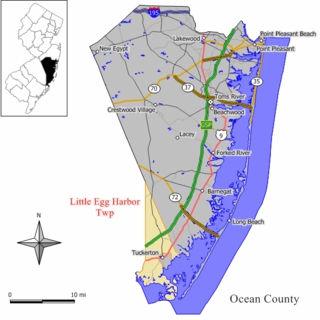
Little Egg Harbor Township is a township in Ocean County, New Jersey, United States. As of the 2010 United States Census, the township's population was 20,065, reflecting an increase of 4,120 (+25.8%) from the 15,945 counted in the 2000 Census, which had in turn increased by 2,612 (+19.6%) from the 13,333 counted in the 1990 Census. The 2010 population was the highest recorded in any decennial census.
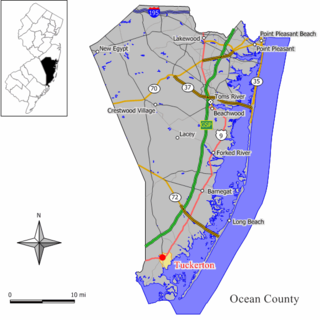
Tuckerton is a borough in Ocean County, New Jersey, United States, named for founder Ebenezer Tucker (1758–1845), and was a port of entry, but not the third Port of Entry in the United States, as is often described. As of the 2010 United States Census, the borough's population was 3,347, reflecting a decline of 170 (−4.8%) from the 3,517 counted in the 2000 Census, which had in turn increased by 469 (+15.4%) from the 3,048 counted in the 1990 Census.
U.S. Route 9 is a U.S. highway in the northeast United States, running from Laurel, Delaware north to Champlain, New York. In New Jersey, the route runs 166.80 mi (268.44 km) from the Cape May–Lewes Ferry terminal in North Cape May, Cape May County, where the ferry carries US 9 across the Delaware Bay to Lewes, Delaware, north to the George Washington Bridge in Fort Lee, Bergen County, where the route along with Interstate 95 (I-95) and US 1 continue into New York City. US 9 is the longest U.S. highway in the state. From North Cape May north to Toms River in Ocean County, US 9 is mostly a two-lane undivided road that closely parallels the Garden State Parkway and runs near the Jersey Shore. Along this stretch, it passes through the communities of Rio Grande, Cape May Court House, Somers Point, Pleasantville, Absecon, Tuckerton, Manahawkin, Beachwood and Berkeley Township. In the Toms River area, US 9 runs along the Garden State Parkway for a short distance before heading northwest away from it and the Jersey Shore into Lakewood Township. Upon entering Monmouth County, the route transitions into a multilane suburban divided highway and continues through Howell Township, Freehold Township, Manalapan Township, Marlboro Township, Old Bridge Township, Sayreville, and South Amboy. In Woodbridge Township, US 9 merges with US 1 and the two routes continue through northern New Jersey as US 1/9 to the George Washington Bridge.



